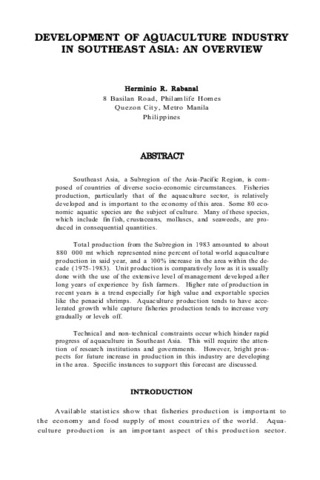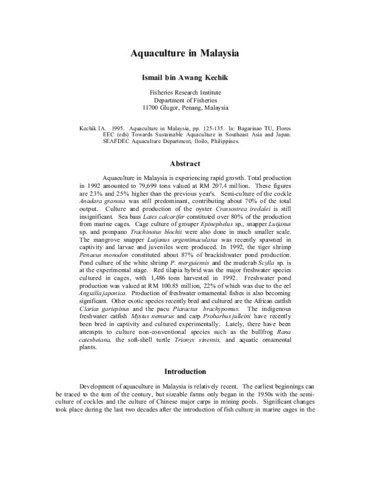Development of aquaculture industry in Southeast Asia: An overview
| dc.contributor.author | Rabanal, Herminio R. | |
| dc.contributor.editor | Juario, Jesus V. | |
| dc.contributor.editor | Benitez, Lita V. | |
| dc.date.accessioned | 2011-06-06T02:33:59Z | |
| dc.date.available | 2011-06-06T02:33:59Z | |
| dc.date.issued | 1988 | |
| dc.identifier.citation | Rabanal, H. R. (1988). Development of aquaculture industry in Southeast Asia: An overview. In J. V. Juario & L. V. Benitez (Eds.), Perspectives in Aquaculture Development in Southeast Asia and Japan: Contributions of the SEAFDEC Aquaculture Department. Proceedings of the Seminar on Aquaculture Development in Southeast Asia, 8-12 September 1987, Iloilo City, Philippines. (pp. 3-37). Tigbauan, Iloilo, Philippines: SEAFDEC, Aquaculture Department. | en |
| dc.identifier.isbn | 971851113X | |
| dc.identifier.uri | http://hdl.handle.net/10862/138 | |
| dc.description.abstract | Southeast Asia, a Subregion of the Asia-Pacific Region, is composed of countries of diverse socio-economic circumstances. Fisheries production, particularly that of the aquaculture sector, is relatively developed and is important to the economy of this area. Some 80 economic aquatic species are the subject of culture. Many of these species, which include fin fish, crustaceans, molluscs, and seaweeds, are produced in consequential quantities. Total production from the Subregion in 1983 amounted to about 880 000 mt which represented nine percent of total world aquaculture production in said year, and a 100% increase in the area within the decade (1975-1983). Unit production is comparatively low as it is usually done with the use of the extensive level of management developed after long years of experience by fish farmers. Higher rate of production in recent years is a trend especially for high value and exportable species like the penaeid shrimps. Aquaculture production tends to have accelerated growth while capture fisheries production tends to increase very gradually or levels off. Technical and non-technical constraints occur which hinder rapid progress of aquaculture in Southeast Asia. This will require the attention of research institutions and governments. However, bright prospects for future increase in production in this industry are developing in the area. Specific instances to support this forecast are discussed. | en |
| dc.language.iso | en | en |
| dc.publisher | Aquaculture Department, Southeast Asian Fisheries Development Center | en |
| dc.subject | South East Asia | en |
| dc.title | Development of aquaculture industry in Southeast Asia: An overview | en |
| dc.type | Conference paper | en |
| dc.citation.spage | 3 | |
| dc.citation.epage | 37 | |
| dc.citation.conferenceTitle | Seminar on Aquaculture Development in Southeast Asia, 8-12 September 1987, Iloilo City, Philippines | en |
| dc.subject.asfa | fishery economics | en |
| dc.subject.asfa | crustacean culture | en |
| dc.subject.asfa | mollusc culture | en |
| dc.subject.asfa | cultured organisms | en |
| dc.subject.asfa | aquaculture | en |
| dc.subject.asfa | aquaculture systems | en |
| dc.subject.asfa | aquaculture economics | en |
| dc.subject.asfa | aquaculture enterprises | en |
| dc.subject.asfa | aquaculture development | en |
| dc.subject.asfa | seaweed culture | en |
| dc.subject.asfa | commercial species | en |
| dc.subject.asfa | aquaculture techniques | en |
| dc.subject.asfa | fish culture | en |
Files in this item
รายการนี้ปรากฏใน (s)
-
ADSEA '87 [20]
Proceedings of the Seminar on Aquaculture Development in Southeast Asia, 8-12 September 1987, Iloilo City, Philippines





